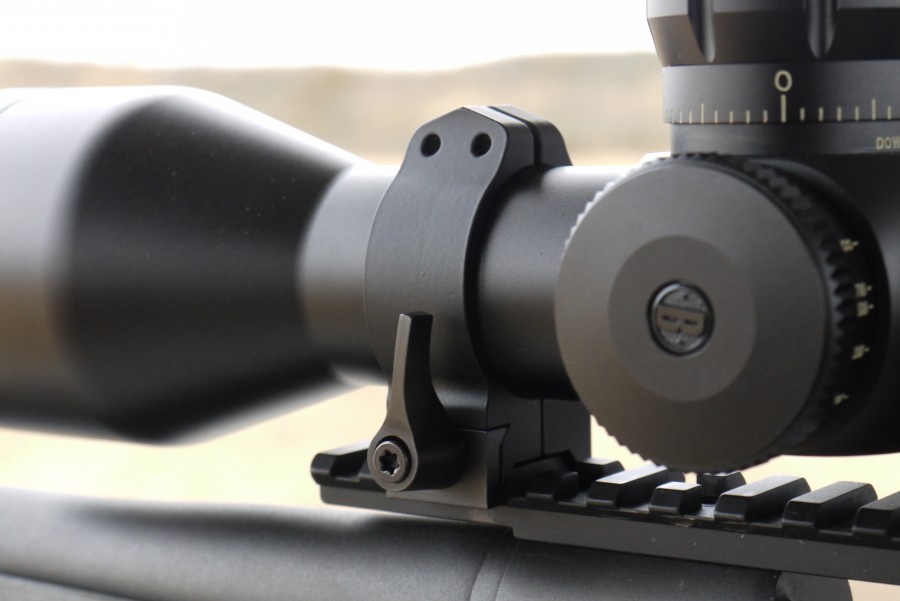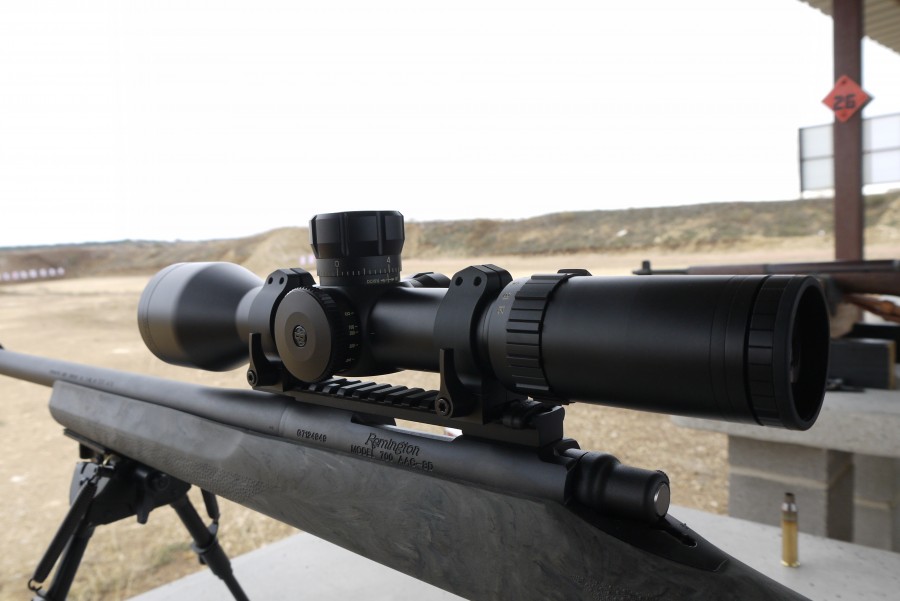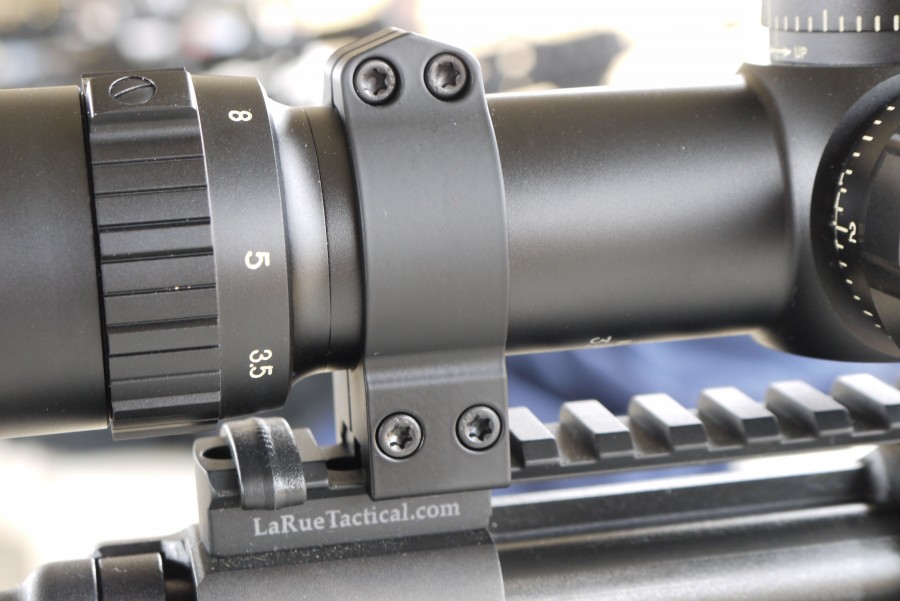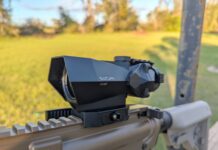Scope mounts aren’t an item that you can simply buy the cheapest version and live with the wobble. Good scope mounts are essential for accurate shots, and quick-detach scope mounts (that return to zero when re-attached) are even better. Unfortunately, the only rings I’ve tested so far that meet those criteria are LaRue’s QD mounts, which clock in at around $200. Until now . . .
Warne is a company name that one doesn’t hear unless they’re “in the know” with the firearms industry — much like Sirchie for investigators and Stryker for EMTs. It’s a company that makes some amazingly good products, but isn’t a household name for some reason. And I really can’t figure out why, since these things are fantastic.
Why are they fantastic? Glad you asked.
There’s a difference between cheap scope rings and good scope rings. The biggest of those differences is in how the rings hug the body of the scope.
Cheap rings will typically have only a small surface area in which they actually contact the body of the scope. The smaller surface contact points mean there’s less friction holding the scope in place, allowing it to move ever so slightly in the rings. They also typically have some pretty piss-poor rail mounts that tend to work themselves loose over time. Trust me, I’ve had my share of cheap mounts, and I know this to be the case.
Some people try to fix the contact issue by “lapping” the inside of the scope rings to make them more perfectly round. That makes them contact the entire surface of the scope. I’ve never done it myself, mainly because it sounds like a gigantic pain in the ass.
Warne’s scope mounts, though, are the exact opposite of these cheap mounts. Precision engineered in the wilds of Oregon (well, just down the street from Leupold actually) they require absolutely zero lapping in order to properly hug your scope. In fact, they’re designed to have a little “give” in the rings so that when you put them on and torque down the screws, the rings will flex slightly to perfectly fit the scope tube.
There is, however, a small issue I have with their construction — not from a technical point of view, but more of a practical one.
On most scope rings, they come in a “top” and “bottom” section. Meaning that you can attach the bottom section of the rings to the rail, and then work on centering and leveling the rings before you tighten them down. Warne’s rings, on the other hand, come in a “left” and “right” section, meaning that mounting the scope to the rail is a bit tougher.
Also slightly annoying: the center piece of the base of the mount, the one that locks into the rail and keeps the mount from moving back and forth, isn’t permanently attached. So when you open the rings to cram your scope inside, be prepared for it to fall out.
The real question, though, is if you can take the scope off the rifle and put it back on again without losing zero. Its the same claim LaRue made with their rings, and so I figured I would re-create the same test I used for LaRue’s mounts and see if they perform as well as the more expensive variety.
Results? Every single round impacted the brand new, freshly painted steel plate within an area about the size of a baseball. At 250 yards. Given that I wasn’t trying to be particularly accurate I’d say that’s a “pass” in my book, especially since the rings performed as well if not better than LaRue’s rings.
What it really boils down to then is what kind of design you prefer. LaRue’s low profile rings seem slightly lower than Warne’s low QD rings (they need room for the screws in the base), plus LaRue’s rings slightly easier to mount and with less worry about losing small pieces. But the whole thing about having a spare $100 is nice, especially when these work just as well.
Warne Quick Detach Scope Rings
Tube: 30mm, 34mm or 1 inch
Price: $100
Overall Rating * * * * *
Half the price of LaRue’s rings and working just as well? Sign me up! So long as you can stand the left / right split instead of the up / down split, that is.







You should lap your rings to avoid torqueing and get even contact. There are kits or a qualified smith can do it for you. It also gives you a good grip on the scope to prevent wandering. The only thing you don’t have to lap is Burris Z rings. They adjust againt torqueing and allow for shimming for longer distance in case you are making the real long shots. Quick tach bases are good for tactical shooting but for benchrest guys of micrometer standards at 200 to 600 yds there is always some shift no matter the quick tach system.
Leupold’s steel QD rings have worked great for me plus they’re a bargain at around $50-$60. They use the up/down method. You might want to check ’em out Nick.
Warne, LaRue, and US Optics make the best rings in my opinion. Thanks for the review. Warne rings with ‘normal’ top bottom ring bases would be awesome.
Talley rings are the best, followed by Leupold, Burris, Weaver and then Warne. Warne rings require three hands and are exasperating to mount. I gave the Warnerings and try and gave them up at a swap shop for some Burris Tacticals..
I just bought a set of DNZ rings. For those who don’t actually need QD, they seem like a great solution. They consist of a solid lower and two upper ring halves. Instead of having separate base and rings, the lower is both the base and the lower half of the rings, machined from aluminum. You screw the lower to your rifle’s receiver, the scope drops on the perfectly round surface, you tighten the top half of the rings to the base, and you’re done. All hex head screws, wrench included. They’re a lot more expensive than the Chinese imitation Weaver mounts at WalMart, but for less than fifty bucks they eliminate a lot of opportunities for things to go wrong.
I could see using a rail base if your particular scope and rifle combination needs extreme fore and aft adjustability, but on my particular Savage .17 HMR with Nikon Buckmaster 4.5-14 combination, there is lots of room to slide the tube back and forth to get the correct eye relief.
I use only Warne, but I like then PA style. Here’s a wild idea: one piece base and all the rings you can get on a scope. I can get 3 on a Bushnell 4200 elite. Some scopes with long tubes can handle 4.
To what point? I realize the need for more than two rings on hard hitting pistols and T/C Contenders but I don’t quite see the utility of more than two rings for rifles.
More the merrier. Hunting rifles are dropped, beat around on atvs and generally handled rough. So is the nature of the game. More bearing surface can’t hurt. Kinda like 30 round mags, you don’t need them until you do.
Point taken and my perspective is duly revised.
Take a peek at Leupolds QRW rings, they have the tradtional top cap, and the same quick release system as the Warne rings, some might even say that if you look close enough, the QRW’s are being made for Leupold by Warne…
http://www.leupold.com/hunting-shooting/mounting-systems/qrw-mounting-systems/
Hope this helps
I use the QRW rings on a 300 win mag, outstanding quality and easy to install.
Hey Nick, love your work here at TTAG but you should know that Stryker isn’t exactly a pro 2a company.
I don’t know if it was written or not and I just didn’t catch it but what is the height of the rings your using in this test? thank you
I know this is an extremely old post, but just google Warne Mounts & you’ll find all the specs you need. Scopes come in a variety of widths /lengths/heights as do rifles so it wouldn’t do you a bit of good to know what size Leghorns using in a picture. Not unless you have the exact identical scope/ rifle he does. Warne lays it out very nicely on there page… Good luck
Am ah picky feller when it comes ta mounts, sayin that the, Warne look every bit as good as the Tally, but cheaper.http://www.amazon.com/Talley-Quick-Detachable-Lever-MedMatte/dp/B00HSK22VA/ref=sr_1_13?ie=UTF8&qid=1455266184&sr=8-13&keywords=Talley+Quick+Detachable+Ring+with+Lever Leupolds look nice to with the easyer ta mount top and bottom style. I just put non detach Warne’s on my 270 WSM but I think I’m returnin em for the detach. I got a Savage 116 Weather Warrior with ah 24″ barrel so it aint no light weight. Only draw back is is the gun is Stainless with composite stock. Kinda like you could use it for ah boat paddle. Maybe just pitch it on the ground when yer done for the season then dust it off when ya get back to yer next year. Ha!!
If it were ah light weight gun I think I would stick with ah good brand alum base and mounts for weather resistance and weight.
I realize this is an old post but I had a good laugh reading it. Leghorn you cant say enough good about how well these rings grab, how there’s no lapping needed & how well they hold zero!! There’s a reason for that Leghorn, you also mention you dont know why they would engineer these rings Vertically (key point) vs Horizontally LOL. thats the part that gets me coming from a person speaking on behalf of firearms/products . I dont have enough time to explain the geometry behind vertical vs horizontal. what I can say is that everything you love about these rings is directly tied to the vertical build you dont care for. One could never get the same non lapping concentric & return to zero in a horizontal ring and for good reason, unfortunately I don’t have time to elaborate. Otherwise great post
Anyone considering to buy these rings should also watch this video by RifleChair (https://www.youtube.com/watch?v=Hnps8TtqWU4 ) which indicates that Warne’s QD rings lose zero by 3 to 4 MOA every time the scope is detached, then reattached. An ethical company wouldn’t inflate what their product is capable of doing. I’m returning the set of Warne QD rings I bought…
Thanks for explaining that ease of mounting is also one of the things to consider when it comes to scope rings. I’d like to know more about those because I’d like to get new upgrades for my gun soon. That would be great to have since I plan to go on a hunting trip within the year.
Comments are closed.